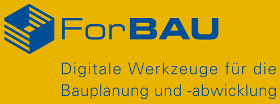FORBAU
RESEARCH ASSOCIATION VIRTUAL CONSTRUCTION SITE

BAUIDENT
STATUS QUO
This sub-project sets out to record the progress made on the actual building site promptly and expediently using state-of-the-art identification and communication techniques to allow the construction processes and the appropriate material and information flows to be managed in an effective manner.
The computational gap in data transfer between the real physical world with its objects and the world of virtual planning can be bridged using a simulation model with the help of automatic identification (AutoID) technologies. Data required for managing logistical processes, for example, can be collected faster, more precisely and with fewer errors thanks to automatic statistical process control. So AutoID systems make it possible to plan and manage procedures with more accurate information.
The challenges for identification and control technology in the building industry consist primarily of:
- the reliable identification of all "objects", such as materials, equipment, machinery, appliances and tools, that are crucial for the construction process
- their localization before and during the mobile, continually shifting building process
- the ability to manage such objects - either oneself or with outside assistance - according to the process or the requirements concerned
- the neutral integration of diverse mobile AutoID systems and the different makes of machine controls available into a joint concept
It is important that these tasks are executed regularly and reliably, even in the face of unfavourable ambient conditions.
THE AIM
The purpose of the project is to bring the real, physical world a bit closer to the virtual world of IT planning and control systems and to achieve much greater transparency on the building site in an economical, automated manner.
Important partial objectives of SP 4 include:
- status quo analysis and systematization of all the relevant objects and appropriate processes on the site, focussing on recognizing innovative application potential for identification technologies
- economic assessment of the relevant activities in the building processes, costs and secondary effects of modified and improved identification, localization and control techniques
- identification of specific requirements and options for the choice of AutoID modules and system configurations, taking the special aspects of the building industry (dirt, mechanical stress, mobility, metallic environment, environmental factors, etc.) into account
- development of models and concepts for the integration of suitable RFID and Smart Object technologies into existing or emerging IT landscapes.
PROJECT DESCRIPTION
In the first year of the project, research will focus on part classification and process design. The initial step will be to record, classify and describe building components, operating equipment, machines and tools that are employed on the building site from the point of view of their properties using process data recording techniques and by talking to the industrial partners. The properties of the structure are a vital prerequisite for determining the technology to be used. In the following section, we analyse the processes that have been recorded and describe the potential that is opened up through the use of identification technologies. Tests on various demonstrators will serve to validate the theoretical results.
Part classification
Not all materials used on the site are suitable for RFID tagging. This depends in particular on the properties of the structure, their value and significance in the construction process. For this reason, a methodology is to be devised to decide which objects lend themselves to tagging. Not only the value and number of objects but also the processes and their logistical criticality will be taken into account.
A combination of conventional identification technology and RFID technology that has been especially adapted to the building sector allows material flow and transport chains on the building site to be monitored and recreated across all processing stages. Besides tracking construction vehicles that regularly leave the site during the building phase, operating equipment such as shuttering boards/components or small machines that are allocated to a building site and remain more or less stationary for longer periods of time will also be registered. Apart from providing greater transparency in the execution of the development, i.e. through the exact calculation of operating hours etc., the tracking of construction vehicles, operating equipment and tools also affords protection against theft, temporary misplacement and misstorage, thus holding a greater monetary potential.
Process design
For each object (construction machines, operating equipment, materials etc.), a rough sketch is made of the processes that these objects undergo which is accompanied by a description of the possible application potential for the object category concerned. Based on the rough processes and respective application potential, identification points are positioned in the process in such a way that it is possible to exploit the application potential. As a rule, a process redesign is required in order to achieve this goal, i.e. a new process that takes the new technology into account is set up.
The result is an overview of the targeted application potential for each sub-category coupled with a description of a process with which this potential can be tapped.
Contact
Dipl.-Ing. Cornelia Klaubert



